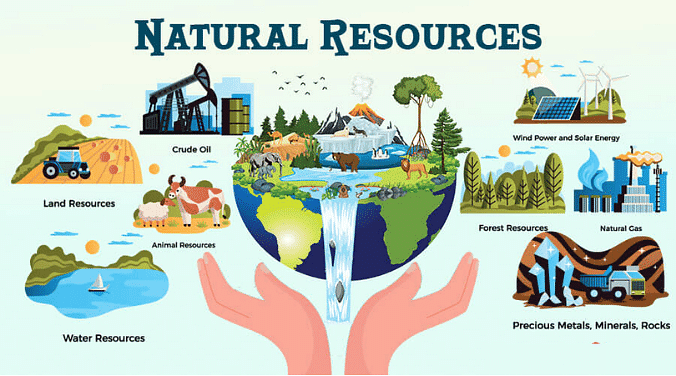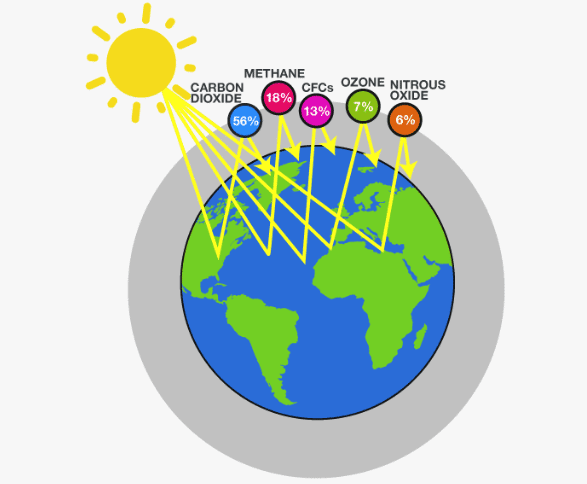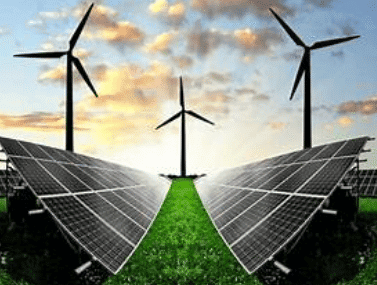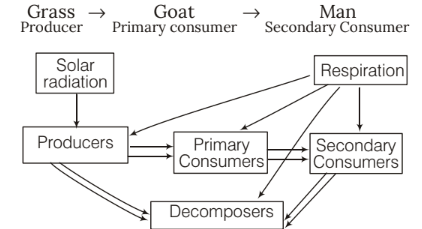Notes: Natural Resources | Science & Pedagogy Paper 2 for CTET & TET Exams - CTET & State TET PDF Download
| Table of contents |

|
| Natural Resources and its Types |

|
| Water |

|
| Solid Waste Management |

|
| The Soil |

|
| Mineral Resources in India |

|
| Energy Resources |

|
| Conservation of Energy Resources |

|
| Ecosystem |

|
| Biodiversity |

|
Earth is the sole planet that sustains life because of the existence of essential natural resources such as air, water, soil, sunlight, etc.

Natural Resources and its Types
Natural resources are materials obtained from the Earth that are useful to humans. They occur naturally and cannot be created by human beings. Examples include air, water, minerals, etc. Based on their availability, natural resources are broadly classified into two types:
- Inexhaustible Natural Resources: These are available in unlimited quantities and are not likely to be depleted by human activities. Examples include sunlight and air.
- Exhaustible Natural Resources: These are present in limited quantities and can be exhausted by human activities. Examples include forests, wildlife, minerals, coal, petroleum, and natural gas.
Air
Our Earth is enveloped by a thin layer of air, known as the atmosphere, which extends many kilometers above the Earth's surface.
- The atmosphere is composed of several gases: nitrogen (78%), oxygen (20.95%), carbon dioxide (0.031%), argon (0.93%), and other gases like water vapor and trace gases, making up about 0.04% of the atmosphere.
- The balance of oxygen and carbon dioxide in the atmosphere is maintained by processes like photosynthesis and respiration.
Layers of the Atmosphere
The atmosphere is divided into layers based on temperature:
- Troposphere: This is the layer closest to the Earth's surface, extending up to about 10-15 km. It contains the air we breathe and is where weather occurs.
- Stratosphere: Above the troposphere, extending from about 15-50 km above the Earth's surface. The stratosphere contains the ozone layer, which absorbs and scatters solar ultraviolet (UV) radiation.
- Mesosphere : The mesosphere is situated directly above the stratosphere, extending from 50-80 km above the Earth’s surface.
- Thermosphere : This layer extends from 80 km above the earth’s surface to outer space.
Air Pollution
Air pollution occurs when unwanted substances contaminate the air, harming both living and non-living things.
- Air pollutants can be primary (directly emitted) or secondary (formed by chemical reactions in the atmosphere).
- Examples of primary pollutants include ash, carbon monoxide, sulfur dioxide, CFCs, and carbon dioxide.
- Secondary pollutants include compounds like Peroxy Acyl Nitrate (PAN).
- These pollutants are harmful to health and the environment, leading to respiratory issues, ozone depletion, and global warming.
- Control of air pollution is challenging but can be managed through careful planning and technology improvements.
Greenhouse Effect
The greenhouse effect is caused by gases in the atmosphere trapping solar energy, warming the Earth's surface and air above it.
- Greenhouse gases like water vapor, carbon dioxide (CO2), and methane contribute to the greenhouse effect.
- Increased concentrations of these gases lead to global warming and climate change.

Water
Water covers about 71% of the Earth's surface, mainly in oceans and seas, and exists in various forms.
- Forms of water include solid (icecaps, glaciers), liquid (oceans, lakes), and water vapor in the atmosphere.
- Freshwater, used for drinking, irrigation, and industrial purposes, is a scarce resource, making up only 0.006% of all water on Earth.
- Groundwater is stored in aquifers below the water table and is vital for human activities.
- Depletion of water resources is accelerated by population growth, industries, and mismanagement.
- World Water Day is celebrated annually on March 22nd to highlight the importance of water conservation.
Water Pollution
Water pollution is the contamination of water bodies due to changes in its physical, chemical, and biological properties.
- Fertilizers and pesticides from agricultural fields dissolve in water and cause harmful algal blooms, cutting off oxygen supply to aquatic life.
- Dumping of sewage and household wastes adversely affects water quality.
- Industries release hot water into water bodies, causing sudden temperature changes that affect aquatic organisms.
- Aquatic animals like Daphnia and Trout are sensitive to pollution levels.
- Water pollution is measured in terms of BOD (Biochemical Oxygen Demand).
- Impact of water pollution includes diseases like cholera, typhoid, dysentery, and jaundice.
- Mercury (Hg) and Cadmium (Cd) cause diseases like Minamata disease and Itai-itai (ouch-ouch) disease, respectively.
- Nitrate-rich water can cause methemoglobinemia, also known as blue baby syndrome.
Water Management
In recent years, water scarcity has increased due to population growth, industrialization, climate change, and agriculture.
- Rainwater harvesting is used to recharge groundwater and manage water availability.
- Drip irrigation delivers water directly to plant roots, conserving water compared to traditional irrigation methods.
Solid Waste Management
- Solid waste management involves the collection, treatment, and disposal of discarded materials that are no longer useful.
- Improper disposal of solid waste leads to unsanitary conditions, environmental pollution, and outbreaks of diseases carried by rodents and insects.
Biodegradable Waste
- Biodegradable waste can decompose over time through natural processes, including composting, aerobic digestion, or anaerobic digestion.
- Examples include paper and fruit peels.
Non-Biodegradable Waste
- Non-biodegradable waste cannot be broken down by natural processes within a reasonable amount of time.
- Examples include plastics, tin, and cans.
The Soil
Soil is a natural cover layering the earth’s surface, composed of water, air, organic matter, and mineral particles.
- It supports plant growth by holding roots firmly and supplying water and nutrients.
- Soil forms the habitat of animals and organisms like rabbits and earthworms.
- Soil is formed by the process of weathering, known as pedogenesis.
Soil Profile
A vertical section through different layers of the soil is called the soil profile, consisting of horizons.
- Plants are classified based on the nature of soil they grow in, such as oxylophytes (acidic soil), halophytes (saline soil), psammophytes (sandy soil), and lithophytes (rock surfaces).
- Waterlogged soils reduce oxygen and nutrient supply to roots, leading to their death.
- Many organisms like protozoans, rotifers, and earthworms enhance soil quality.
Types of Soil
Soil types depend on the rocks and are classified based on the proportion of various-sized particles.
- Laterite Soils
- Red Soils
- Tundra Soils
- Red Desert Soils
- Black Soils
- Red and Yellow Soils
- Mountainous Soils
- Marshy Soils
- Podzols
Soil Erosion
Soil erosion is the removal of land surface by water, wind, or ice, exacerbated by deforestation and improper land use.
Manures
- Manures and fertilizers are substances added to the soil to provide essential nutrients for plant growth.
- Manures improve soil fertility by adding organic matter and nutrients.
- Manuring replenishes soil nutrients, ensuring healthy plant growth.
- Insufficient or improper manuring leads to weak plants.
Characteristics of Organic Manure
- Easily available and can be used in all conditions.
- Replenishes soil nutrients and retains them for a longer time.
- Completely safe for use without causing any harmful effects on the soil.
- Promotes the growth of eco-friendly microbes in the soil.
Fertilisers
Fertilisers are chemical substances rich in nutrients like nitrogen, phosphorus, and potassium.
- Organic Fertilisers: Derived from animal and vegetable matter.
- Inorganic Fertilisers: Mined or manufactured from synthetic compounds.
Land Resources
- Land is a vital resource supporting natural vegetation, wildlife, human life, and economic activities.
- It needs careful planning and conservation as it is finite and essential for future generations.
Mineral Resources in India
Mineral resources in India are widespread and diverse. Some of the important mineral resources include iron, manganese, bauxite, mica, copper, and gold.
Types of Mineral Resources
Mineral resources in India can be categorized into two groups:
- Metallic Minerals: These minerals exhibit properties of lustre, solidity, and hardness. They are extracted from the earth in raw state, known as mineral ore. Examples include gold, silver, copper, iron, zinc, lead, and tin.
- Non-Metallic Minerals: These minerals do not contain metals and are used for the extraction of non-metals like sulphur, phosphorus, and carbonates. Examples include limestone, antimony, mica, and gypsum.
Minerals are exhaustible resources and need to be preserved. Efficient utilization, recycling, and advanced technology for extraction and refinement are crucial for their preservation.
Iron Ore
Iron ore is the backbone of industrial development in India. The country has abundant resources of good quality iron ore:
- The finest iron ore is magnetite, which has a very high iron content (up to 70%) and excellent magnetic qualities.
- Haematite ore has an iron content of 50-60% and is the most important industrial iron ore in terms of quantity used.
The major iron ore belts in India are:
- Odisha-Jharkhand Belt
- Durg-Bastar-Chandrapur Belt
- Ballari-Chitradurga-Chikkamagaluru Tumakuru Belt
- Maharashtra-Goa Belt
Energy Resources
Energy resources are required for all activities. They can be categorized into conventional and non-conventional sources.
- Conventional Sources: These include coal, petroleum, natural gas, and uranium. They are finite and non-renewable.
- Non-Conventional Sources: These include wind power, solar energy, tidal energy, geothermal energy, atomic energy, and biogas. They are freely available and renewable.
Firewood and cattle dung cake are common in rural India, meeting over 70% of energy needs in rural households. Continuous use decreases forest area, and dung cake use is discouraged due to its impact on agriculture and smoke production.
Conventional Sources of Energy
Some prominent conventional sources of energy include:
- Coal: An important fossil fuel with varieties like peat, lignite, bituminous, and anthracite. Used in metallurgical processes, coal gas production, and as a reducing agent in metal extraction.
- Coal Gas: Mixture of hydrogen, methane, and CO, used in metallurgical processes and as a heat source.
- Coke: Contains 80-95% carbon, used as smokeless fuel and in steelmaking.
- Charcoal: Produced by burning carbon compounds in the absence of air, used in various industries.
- Lamp-black: Produced by burning carbon-rich oils, used in printer ink and varnishes.
- Gas Carbon: A byproduct of coal destructive distillation, used in electrode production.
Petroleum
Petroleum, also known as crude oil or black gold, is a dark oily liquid formed from microorganisms under the sea and found in the pores of sedimentary rocks.
It is a complex mixture of hydrocarbons formed over millions of years due to high pressure, heat, and catalytic actions.
- The process of separating various constituents of petroleum is called refining, which is carried out in a petroleum refinery.
- Crude oil refining is done in a fractional distillation column, where different hydrocarbons with varying boiling points are collected at different levels.
- Many useful substances termed as petrochemicals are obtained from petroleum and natural gas.
- Compressed Natural Gas (CNG), which mainly contains methane, is a cleaner fuel compared to petrol, requiring higher combustion temperature.
Compressed Natural Gas (CNG)
- CNG is a mixture of hydrocarbons, mainly methane (80-90%), known for its low emission of harmful gases, reducing pollution.
- It burns at a higher temperature (540°C) compared to petrol (232-282°C) and is colorless, odorless, and lighter than air.
- Natural gas is stored under high pressure as Compressed Natural Gas (CNG).
Electricity
Electricity is indispensable in today’s world and a key indicator of development.
- Electricity is conventionally generated by burning fossil fuels like coal, petroleum, and natural gas in thermal power plants.
- Hydroelectricity, generated by flowing water, is a pollution-free and renewable resource widely used in India.
- Several multi-purpose projects harness river water power, such as Bhakra Nangal, Damodar Valley, and Krishnarajasagara.
Rocket Propellants
- Rocket propellants are fuels used in rockets, characterized by high compactness and calorific value.
- They are classified into liquid propellants (e.g., liquid hydrogen, alcohol) and solid propellants (e.g., synthetic rubber, ammonium perchlorate).
- Some propellants like N2O4 are mixed, combining solid fuel and liquid oxidizer, while others like liquid H2 + liquid O2 are used as liquid propellants.
Biomass
- Biomass refers to the volume of living organisms per unit area and is a renewable source of energy.
- The biomass used for heat generation includes wood, agricultural wastes, and cattle dung.
Non-Conventional Sources of Energy
India, being a tropical country, is rich in renewable energy resources. Due to environmental concerns associated with non-renewable resources, there is a growing emphasis on renewable sources.

Some prominent non-conventional sources of energy include:
Nuclear Power
- India is rich in atomic minerals like uranium and thorium.
- Atomic power plants are located in Tarapur, Rawatbhat, Kalpakkam, and Narora.
Solar Energy
- Solar energy minimizes dependency on firewood and cow dung, contributing to environmental conservation.
- India’s largest solar power plant is located near Bhuj in Rajasthan.
Wind Power
- Wind energy is harnessed through windmills set up in windy areas like Nagercoil-Madurai belt and Jaisalmer.
Biogas
- Biogas is produced from organic matter including shrubs, farm waste, and animal and human wastes.
- Biogas plants, known as Gobar gas plants, are set up at municipal, cooperative, and individual levels in rural India.
- It improves energy efficiency compared to kerosene, charcoal, or dung cakes, and enhances the quality of manure.
Tidal Energy
- Tidal energy is generated from oceanic tides and can be harnessed using floodgate dams.
- In India, ideal conditions for tidal energy are found in the Gulf of Khambhat, Gulf of Kuchchh, and the Gangetic delta in West Bengal.
Geothermal Energy
- Geothermal energy utilizes heat from the earth's interior and is found in areas with high geothermal energy concentration.
- It is associated with hot springs and provides heat and electricity.
Conservation of Energy Resources
Energy conservation is crucial for sustainable development and involves promoting renewable energy sources and avoiding wastage.
- Methods to conserve energy include using public transport, switching off electrical appliances when not in use, and employing power-saving devices.
- Increased use of non-conventional sources of energy helps in conserving natural resources.
"Energy saved is energy produced."
Ecosystem
Ecology studies the interaction between organisms and their environment, while an ecosystem refers to the complex system of interaction between organisms and their physical environment.
Components of Ecosystem
- Biotic Components: Plants, animals, and microorganisms.
- Abiotic Components: Atmospheric, lithospheric, and hydrospheric components.
Functioning of Ecosystem
An ecosystem functions through energy transmission among its components, primarily through photosynthesis where plants convert light energy into carbohydrates and biochemical molecules.
Food Chain
The transfer of energy through a series of steps in an ecosystem is known as a food chain. Organisms are grouped into trophic levels based on their position in the chain:
- First Trophic Level: Producers like plants
- Second Trophic Level: Primary consumers like herbivores
- Third Trophic Level: Secondary consumers like carnivores
Example: Grass (Producer) → Goat (Primary Consumer) → Man (Secondary Consumer) Flow of Energy through Food Chain
Flow of Energy through Food Chain
Biodiversity
- Biodiversity refers to the variety and variability of life forms on Earth, including all plants, animals, and microorganisms.
- Biodiversity hotspots are regions with exceptionally high levels of species diversity and endemism, and they are under constant threat.
- India hosts two biodiversity hotspots: the Eastern Himalayas and the Western Ghats.
Conservation of Biodiversity
- Biodiversity faces threats such as habitat loss, overexploitation of resources, and poaching.
- Conservation efforts include protecting critical habitats, preventing poaching, reducing pollutants, and establishing national parks and wildlife sanctuaries.
Strategies for Conservation of Biodiversity
- Identify and safeguard critical habitats for each species.
- Prevent poaching and hunting of wildlife.
- Reduce environmental pollutants.
- Establish national parks and wildlife sanctuaries for the conservation of genetic diversity.
Biosphere Reserve
- Biosphere reserves are areas that integrate terrestrial, marine, and coastal ecosystems to promote the conservation of biodiversity alongside sustainable use.
- These reserves are largely self-regulating and maintain the balance of life on Earth.
Red Data Book
- A Red Data Book, maintained by the International Union for Conservation of Nature (IUCN), lists taxa at risk of extinction.
- The first Red Data Book was published on January 1, 1972, and it catalogs species facing the risk of extinction.
Endemic Species of India
- Endemic species are those found only in specific regions, with approximately 60% of India's endemic species located in the Himalayas and the Western Ghats.
- Major concentrations of endemic species are found in North-East India, North-West Himalayas, Western Ghats, and Andaman and Nicobar Islands.
|
35 videos|145 docs|32 tests
|
FAQs on Notes: Natural Resources - Science & Pedagogy Paper 2 for CTET & TET Exams - CTET & State TET
| 1. What are the main types of natural resources discussed in the article? |  |
| 2. How does air pollution impact the environment and human health? |  |
| 3. What are the different types of water pollution mentioned in the article? |  |
| 4. How can solid waste management help in preserving natural resources? |  |
| 5. What are some examples of manures mentioned in the article? |  |















